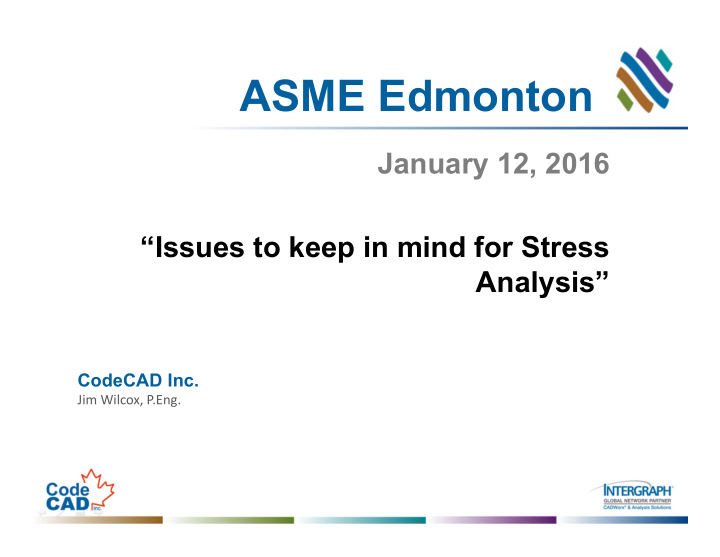



ASME Edmonton January 12, 2016 “Issues to keep in mind for Stress Analysis” CodeCAD Inc. Jim Wilcox, P.Eng.
About CodeCAD Inc. Software sales, support & training Intergraph (COADE) CAESAR II, PV Elite, CADWorx, TANK, GT STRUDL Paulin Research Group FE/Pipe, NozzlePro, FEA Tools Applied Flow Technology Fathom, Arrow, Impulse
Overview Pipe stress software has limitations Beam theory has limits to its applicability Accuracy of pipe stress analysis depends on the accuracy of the model Accurate input Boundary conditions System stiffness properties – components, restraints Current piping codes are based on 1950’s technology Errors in B31 piping codes for over 30 years. Additional research required. Research done, improvements to the codes are happening now.
Beam Theory Simply applying beam equations No buckling No changes in component stiffness No local stress considerations [K]{d}={F} Stiffness properties matter
Beam Theory
Beam Theory
Accuracy Accurate input Boundary conditions System stiffness properties
Accuracy
History of Piping Codes 3000 BC – Mesopotamia: Baked clay pipe for water distribution – China: Bamboo pipes carry water or gas – Egypt: copper sheets hammered into cylinders used as water pipes 1652 – First US water works in Boston 1738 – Bernoulli publishes “Hydrodynamica” 1808 – First steam boat, 150 psi steam, 4 mph 1817 – Philadelphia city council recommends safety valves on ship boilers 1830 – Franklin Institute investigates steam boiler explosions 1865 – Steamship Sultana explodes, killing 1800 returning prisoners of war 1903 – Metallographic analysis of stages of fatigue failure 1905 – Explosion in a Massachusetts shoe factory kills 58 1908 – Massachusetts enacts first boiler construction law
History of Piping Codes 1911 – First ASME committee for boilers and vessels 1915 – Power Piping Society 1st national code for piping 1926 – First meeting of “Project B31” committee 1942 – ASME B31 “American Standard Code for power piping” 1955 – B31 code splits into separate books 1955 – Markl’s thermal expansion formula introduced in B31.1 1957 – First computerized analysis of piping systems 1959 – First publication of B31.3 1987 – WRC 329 recommends changes: B31.1, B31.3 & ASME III Class 2 & 3 piping 2004 – B31.3 implements Appendix P, f > 1 . 0 2010 – B31.3 specifies Sustained stress calculation 2012 – B31.3 revises Expansion stress calculation 2015 – ASME publishes STP-PT 073 / “More Applicable Data”
History of SIFs Markl fatigue testing:
History of SIFs Current B31.3 SIFs
History of SIFs and “k” Factors Late 1940’s: A.R.C. Markl of Tube Turns leads the effort to develop geometry-based multipliers for component flexibility and stress. 1981: R.W. Schneider (formerly of Bonney Forge) notifies ASME of the non- conservative SIF for reduced outlet tees. 1987: In response to Schneider’s conclusions, E.C. Rodabaugh authors WRC Bulletin 329 (Dec. 1987) – “Accuracy of Stress Intensification Factors for Branch Connections”. (Rodabaugh worked with Markl on the original tests in the late 1940’s.) 2007: A.W. Paulin starts an ASME project to realign stress intensification factors between the Code Books (ASME ST-LLC 07-02 and ASME STP-PT 073). 2012: Paulin updates B31J to accommodate ASME Scope change to include k- factors, and sustained stress indices, along with the most currently applicable data for SIFs in piping systems.
Current Piping Codes Still Use Old Conclusions
In an Effort to Permit Improvement … The Codes permit “more applicable data” to be used so that Engineers can address: Inaccuracies in the Codes and Standards Assumptions made by the Codes and Standards More recent works and studies
WRC 329 Identifies Several Problems w ith Existing Codes – p.28 “The Mob tests indicate that there is a peak somewhere around 0.75.” [d/D=0.75]
In an Effort to Permit Improvement … This note (below) from B31.3 Appendix D alerts the user to possible non-conservative results when using Code rules.
WRC 329 Identifies Several Problems w ith Existing Codes p. 22 “For run moments on branch connections with small r/R, both intuition and Ref. 26 data indicate that the B31.3 relationship ii = 0.75io + 0.25 is at best, reversed in relative magnitude of iir and ior, … and in effect, [the] Code requirements are obviously silly .”
WRC 329 Identifies Several Problems w ith Existing Codes
Paulin Research Group Tony Paulin, P.E.
ASME STP-PT073 Project Conclusions Flexibilities for header and branch are necessary: (current Piping Codes assume rigid branch connections). Separate SIFs are provided for header and branch: (current Piping Codes use the same SIF for both header & branch). SIFs are given for in-plane, out-plane and torsion: (Power Codes don’t differentiate between in-plane and out-plane, and Process Codes don’t intensify torsion). The revised SIF & “k-factor” equations include the branch diameter and thickness, as well as the pad thickness (if specified). So the ratio of branch size to header size is accounted for.
ASME STP PT 073 Alignment of Stress Intensification and Flexibility Factors Paulin Research Group
ASME STP-PT073 (formerly ST-LLC 07-02) Align Stress Intensification and Flexibility Factors Paulin Research Group
FEA Tools o Corrects well known SIF errors using FEA or STP-PT073 o Provides k-factors using FEA or STP-PT073 o Provides SSI values o CAESAR II file conversion utility o CAESAR II results comparison tool o Other utilities not related to this talk….
Recommend
More recommend